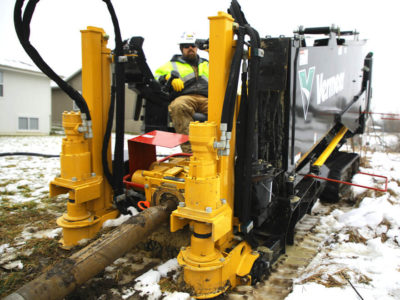Horizontal directional drilling (HDD) work does not stop when the temperature plummets. Keeping crews productive in below-freezing conditions requires advanced planning and preparation. When the temperatures start descending toward the 32-degree Fahrenheit (0º C) mark, make it a priority to winterize the onboard fluids (mud) system on your horizontal directional drill.
Residual drilling fluid left in the system can freeze, expand and crack components and may damage the mud pump. So it’s important to purge fluids from the drill’s onboard mud system with antifreeze before it freezes to help protect these components.
Develop an action plan
Don’t let the weather catch you by surprise. Be proactive and develop an action plan well before the winter season arrives. Winterizing the onboard fluid system of your Vermeer HDD can be broken down into seven steps.
Step 1
The first step in the antifreeze process is to flush the mud pump with clean water to remove residual drilling fluids. Before removing the supply hose from the mud pump, use the dump valve to release the fluid pressure in the system. Then close the dump valve and cap the mud pump inlet.
Step 2
Check the onboard antifreeze tank for an adequate amount of Navigator® HDD Freeze Guard antifreeze. Now, open the antifreeze supply valve to allow fluid into the mud pump.
Step 3
The next step is done at the operator station with the drill running at a low idle. Check that the front vise is open, and the drilling fluid system is turned on.
Step 4
Next, press the drilling fluid flow set point key and set to a low flow rate. Setting the flow rate too high or pressing the full flow button can cause cavitation, which can be harmful to the pump.
Step 5
Run the mud pump until you see a steady stream of antifreeze coming from the subsaver and then shut the pump off.
Step 6
If the wash wand was used to clean the drill, you will need to flush it with antifreeze as well. Connect it to the drilling pump quick coupler. Spray the fluid into the tank until a steady stream of antifreeze is seen coming from the wand. Before disconnecting the wash wand, properly shut down the machine and relieve pressure from the wand.
Step 7
Lastly, be sure to close the antifreeze supply valve. Use these steps the next time you are working in freezing temperatures.
As the winter season can be long in the Northern climates, drilling in freezing temperatures is a common occurrence. By adhering to the seven-step winterization process, you can help prevent horizontal directional drilling fluid systems from freezing and keep projects on track. Please refer to your operator’s manual for safety messages and more information.
Vermeer Corporation reserves the right to make changes in product engineering, design and specifications; add improvements; or discontinue manufacturing or distribution at any time without notice or obligation. Equipment shown is for illustrative purposes only and may display optional accessories or components specific to their global region. Please contact your local Vermeer dealer for more information on machine specifications.
Vermeer, the Vermeer logo and Navigator are trademarks of Vermeer Manufacturing Company in the U.S. and/or other countries. © 2022 Vermeer Corporation. All Rights Reserved.
